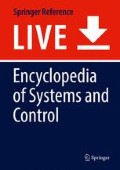Abstract
Adaptive control of linear time-invariant (LTI) systems deals with the control of LTI systems whose parameters are constant but otherwise completely unknown. In some cases, large norm bounds as to where the unknown parameters are located in the parameter space are also assumed to be known. In general, adaptive control deals with LTI plants which cannot be controlled with fixed gain controllers, i.e., nonadaptive control methods, and their parameters even though assumed constant for design and analysis purposes may change over time in an unpredictable manner. Most of the adaptive control approaches for LTI systems use the so-called certainty equivalence principle where a control law motivated from the known parameter case is combined with an adaptive law for estimating on line the unknown parameters. The control law could be associated with different control objectives and the adaptive law with different parameter estimation techniques. These combinations give rise to a wide class of adaptive control schemes. The two popular control objectives that led to a wide range of adaptive control schemes include model reference adaptive control (MRAC) and adaptive pole placement control (APPC). In MRAC, the control objective is for the plant output to track the output of a reference model, designed to represent the desired properties of the plant, for any reference input signal. APPC is more general and is based on control laws whose objective is to set the poles of the closed loop at desired locations chosen based on performance requirements. Another class of adaptive controllers for LTI systems that involves ideas from MRAC and APPC is based on multiple models, search methods, and switching logic. In this class of schemes, the unknown parameter space is partitioned to smaller subsets. For each subset, a parameter estimator or a stabilizing controller is designed or a combination of the two. The problem then is to identify which subset in the parameter space the unknown plant model belongs to and/or which controller is a stabilizing one and meets the control objective. A switching logic is designed based on different considerations to identify the most appropriate plant model or controller from the list of candidate plant models and/or controllers. In this entry, we briefly describe the above approaches to adaptive control for LTI systems.
Bibliography
Astrom K, Wittenmark B (1995) Adaptive control. Addison-Wesley, Reading
Egardt B (1979) Stability of adaptive controllers. Springer, New York
Fekri S, Athans M, Pascoal A (2007) Robust multiple model adaptive control (RMMAC): a case study. Int J Adapt Control Signal Process 21(1):1–30
Goodwin G, Sin K (1984) Adaptive filtering prediction and control. Prentice-Hall, Englewood Cliffs
Hespanha JP, Liberzon D, Morse A (2003) Hysteresis-based switching algorithms for supervisory control of uncertain systems. Automatica 39(2):263–272
Ioannou P, Fidan B (2006) Adaptive control tutorial. SIAM, Philadelphia
Ioannou P, Kokotovic P (1983) Adaptive systems with reduced models. Springer, Berlin/New York
Ioannou P, Sun J (1996) Robust adaptive control. Prentice-Hall, Upper Saddle River
Kuipers M, Ioannou P (2010) Multiple model adaptive control with mixing. IEEE Trans Autom Control 55(8):1822–1836
Landau Y (1979) Adaptive control: the model reference approach. Marcel Dekker, New York
Landau I, Lozano R, M’Saad M (1998) Adaptive control. Springer, New York
Morse A (1996) Supervisory control of families of linear set-point controllers part I: exact matching. IEEE Trans Autom Control 41(10):1413–1431
Narendra K, Annaswamy A (1989) Stable adaptive systems. Prentice Hall, Englewood Cliffs
Narendra K, Balakrishnan J (1997) Adaptive control using multiple models. IEEE Trans Autom Control 42(2):171–187
Sastry S, Bodson M (1989) Adaptive control: stability, convergence and robustness. Prentice Hall, Englewood Cliffs
Stefanovic M, Safonov M (2011) Safe adaptive control: data-driven stability analysis and robust synthesis. Lecture notes in control and information sciences, vol 405. Springer, Berlin
Tao G (2003) Adaptive control design and analysis. Wiley-Interscience, Hoboken
Author information
Authors and Affiliations
Editor information
Editors and Affiliations
Rights and permissions
Copyright information
© 2014 Springer-Verlag London
About this entry
Cite this entry
Ioannou, P.A. (2014). Adaptive Control for Linear Time-Invariant Systems. In: Baillieul, J., Samad, T. (eds) Encyclopedia of Systems and Control. Springer, London. https://doi.org/10.1007/978-1-4471-5102-9_111-1
Download citation
DOI: https://doi.org/10.1007/978-1-4471-5102-9_111-1
Received:
Accepted:
Published:
Publisher Name: Springer, London
Online ISBN: 978-1-4471-5102-9
eBook Packages: Springer Reference EngineeringReference Module Computer Science and Engineering

